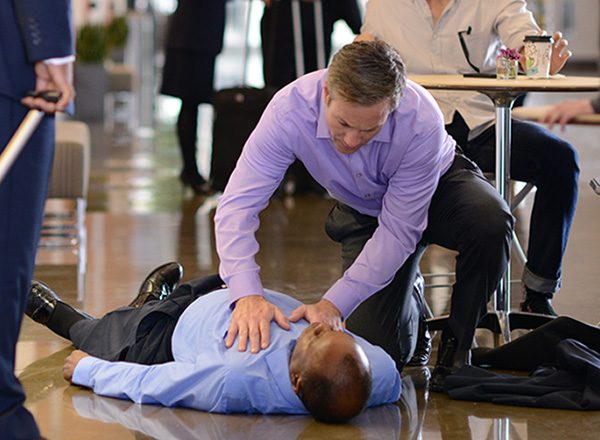Why is traditional CPR training failing telecommunicators—and ultimately failing to eliminate preventable deaths from cardiac arrest? First, let’s look at the numbers. We know that 350,000 people experience out-of-hospital cardiac arrest in the U.S. each year, and only one in ten victims survive. We also know that in communities with higher rates of bystander CPR, about twice as many cardiac arrest victims survive—and one of the best ways to increase bystander CPR rates is by giving CPR instructions over the phone to 911 callers. This means the way emergency telecommunicators handle cardiac arrest calls is of critical importance. In fact, telecommunicators own the first 600 seconds of an arrest, and the way they manage that time can greatly impact whether a patient lives or dies.
That’s why it’s so important to question whether traditional CPR training effectively prepares telecommunicators to coach callers to deliver high-quality CPR. Experts say the answer is no. Here’s why.
RECOGNIZING CARDIAC ARREST
Recognizing cardiac arrest over the phone is not as easy as it sounds. Traditional CPR training does not prepare telecommunicators to effectively ascertain whether a patient is in cardiac arrest: You can’t tap someone’s shoulders to see if they’re responsive, or look, listen and feel for breathing, over the phone. CPR training doesn’t provide strategies for overcoming communication barriers, asking the right questions of bystanders and identifying signs such as agonal breathing.
FREQUENCY OF TRAINING
With traditional CPR certification programs, telecommunicators receive some training every two years, but often nothing in between. Yet the evidence overwhelmingly shows that resuscitation skills and knowledge deteriorate after only a few months without ongoing practice. That means the current requirement of one or two days of resuscitation training every 24 months doesn’t allow learners to retain their skills in the long term. To sum it up, they forget what they don’t practice. As they forget, they may also lose confidence—and sometimes not even use the knowledge they have retained.
MEASUREMENT AND QUALITY IMPROVEMENT
Most call centers have a protocol for cardiac arrest calls, but just having a protocol isn’t enough. Compliance with a protocol might mean your telecommunicators are attempting to provide CPR instructions when they recognize a cardiac arrest. But what it doesn’t tell you is whether they’re recognizing every cardiac arrest, how quickly the caller delivers the first CPR chest compression, or the quality of resuscitation delivered to the patient. By monitoring those factors, you’ll have the information you need to provide the right training, at the right time, for your telecommunicators.
WHAT’S THE ANSWER?
Now we know why traditional CPR training falls short for telecommunicators. Let’s talk about what works and why. Based on the evidence1,
Lauren Sanderson, cognitive research director for RQI Partners, explains that research into how adults learn and retain information has shown that lengthy training events held every few years aren’t effective.
“What sets RQI Telecommunicator apart from any other program and has the most contribution to retention is our low-dose, high-frequency—or spaced learning—model,” she says. “RQI T-CPR is a continuous learning environment that’s built on the repetition of practicing skills and knowledge.”
In fact, research shows that low-dose, high-frequency training sessions (or “booster” sessions) more than double retention of high-quality CPR skills.2 It’s clear that this model helps learners stay focused due to short training sessions. Combine that with the high-frequency element, which forces them to actively recall and utilize their knowledge and skills on a regular basis, and there’s more of a chance they’ll confidently and competently talk callers through the steps they need to take to prevent an unnecessary death from cardiac arrest.
Successful training programs start with laying a foundation of knowledge. Once telecommunicators can demonstrate an understanding of those initial concepts, they enter a perpetual learning environment. This approach leads to a deeper processing of knowledge into long-term memory via opportunities of repetition and retrieval.
Sanderson emphasizes that RQI’s programs are based on the use of deliberate practice, which allows emergency telecommunicators to receive either real-time feedback or feedback immediately after the event, with a debrief on how to improve for next time. “Deliberate practice is really homing in on the learner and articulating what they need and what they're struggling with, and how can we improve upon it.”
Linking initial training, continuing education and quality improvement is also critical to a successful T-CPR program, says Julie Buckingham, RQI T-CPR program director and a former emergency communications center training coordinator and quality improvement manager.
Buckingham points out that many states are recognizing the importance of T-CPR and have mandated training for telecommunicators, but not all T-CPR training is created equal. “There are lots of T-CPR training programs out there, but in almost every case, they're one-and-done events,” says Buckingham. “One-and-done training doesn’t significantly improve or sustain performance long-term, so it's ineffective. It may check a compliance box, but it doesn't result in improved skills, improved patient care or improved outcomes.”
Buckingham also emphasizes that finding individual telecommunicators’ areas where they need to improve, and then targeting those in a positive way with training and feedback, helps alleviate their fears and lack of confidence. “We give them a better understanding of what's actually happening during a cardiac arrest and why the speed of their actions is going to impact that patient’s outcome,” she says.
In many systems, telecommunicators can go days, weeks or even months without handling a challenging cardiac arrest case and delivering CPR instructions. Unlike their colleagues in other areas of public safety and healthcare, emergency telecommunicators do not frequently practice their skills outside of actual 911 calls, Buckingham says.
“Simulation training and practice outside of the initial basic academy is not embedded in the culture of public safety communications,” she explains.
Regular training, including simulation, gives these first first responders an opportunity to practice their skills in a safe environment—and be ready to then perform at a high level when they face that situation during a real call. “With simulation training, we can work through the challenges they may have in that process of identification of arrest and delivery,” Buckingham says, “and then provide not just CPR, but high-quality CPR to every patient.”
Find out more about how RQI T-CPR can help you save more lives.









